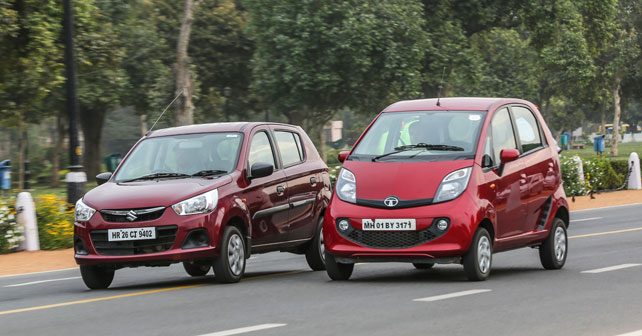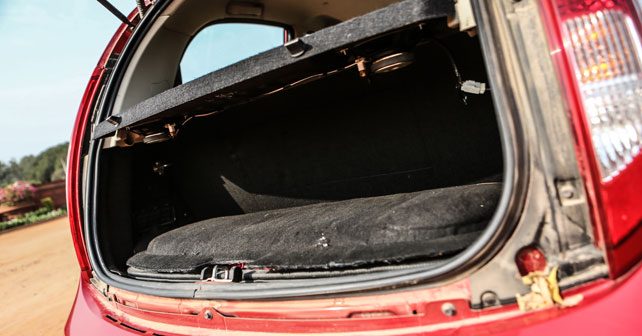AMT gearboxes have changed the market’s outlook by making clutch-less cars available in the A-segment. We pit the Maruti Alto K10 AGS against Tata GenX Nano AMT to find out which is the entry-level clutch-less king.
The A-segment has been synonymous with Maruti Suzuki – be it the retired M800 or the current number one selling car, the Alto, which recently crossed the three million sales mark in the domestic market. Some car manufacturers did dare to challenge Maruti in this segment, but, sadly, they failed to break its hegemony. With an unassailable lead, Maruti refused to sit back on its laurels – rather they decided to push the envelope even further, and introduced a segment-first Automated Manual Transmission (AMT) in the Alto. With the market responding to AMTs positively, Tata Motors decided to crash Maruti’s party with the GenX Nano AMT. The Nano AMT is available in not just one but two variants. Before we get into details, we’d first like to clear a misconception about AMTs. For starters, it is a manual transmission that comes with an ECU (Electronic Control Unit) that activates a hydraulic clutch actuator – which, essentially, acts as your clutch pedal. So, it’s not like your traditional automatic gearbox, but it gets the job done and keeps cost low. By witnessing so many changes in this bread-butter segment, we can safely say that ‘times, they are a changing.’ After all, who would have ever thought that one day this segment would offer automatic cars – well, AMTs anyway.
Even though the Nano and Alto K10 AGS (Auto Gear Shift) target the same buyers, both these cars are quite different from one another. Maruti have plonked the more powerful 67bhp, 998cc engine under the AGS variant’s hood to make sure that power isn’t lacking. The Nano, on the other hand, soldiers on with the same old 624cc motor, which has a maximum power output of 37.5bhp. To tilt the performance levels further in favour of the Alto, its kerb weight is only 755 kilograms – 10 kilograms lighter than the Nano. Also when it comes to breaking tradition, the Nano is one unconventional hatchback as it’s rear wheel drive that has an engine mounted at the back – while the Alto has a traditional layout.
Now both these cars are fitted with a 5-speed AMT, but the performance gap between the two is enough to slot a couple of Nanos in. The Alto, having more ponies than the Nano, is far more responsive. The Nano has a tough time keeping up with the Maruti, and eventually stays in the Alto’s rear view mirror. In automatic mode, both transmissions up-shift quickly in order to keep a strict eye on fuel efficiency. This can be a bit annoying, as just when you gain some momentum the gearbox interrupts with an up-shift at the wrong time.
Personally, if I’m not stuck in bumper-to-bumper traffic, I would choose the manual mode – as both cars offer a lot more punch in this mode. Tata have tried to add some extra juice to the Nano with a Sport button, and it does manage to hold revs a little longer. The secret to getting optimum power delivery from an AMT, though, is to lift off the accelerator pedal just as the transmission is about to up-shift – just as you would do in a manual transmission, in order to avoid getting a surge in between gears.
The Alto certainly has a clear advantage when it comes to power delivery, but how does it fare in terms of passenger comfort and features? Well, step inside the Alto’s cabin and you certainly feel a little hemmed in. However, even though it feels cramped, Maruti has worked hard on the Alto’s interior quality. And this is visible with the redesigned dashboard, which comes with an integrated audio system in a piano black finish. Apart from trying to add an air of premium-ness with dual-tone interiors, Maruti have also added many useful cubby holes, cup holders, utility hooks and bottle holders that come to good use. The Alto’s Achilles heel has always been the lack of legroom for rear passengers, therefore the seatbacks of the front seats are sculpted for slightly better knee space.
With the tall boy shape, the Nano is the king of cabin space. There’s plenty of shoulder and headroom, and the latte coloured cabin features a multi-function instrument cluster – which has two trip metres, instant and average fuel economy readings, and a distance-to-empty reading. The Nano uses the Bolt’s steering wheel, which feels good but it seems as though it’s set a little too low. But it has a great driving position, which provides a clear view of the road. Both the cars come with an integrated music system with a CD player, USB port, and an auxiliary dock, but the Nano offers Bluetooth connectivity as well. Also the Tata is equipped with four speakers compared to the Alto’s front two.
The GenX Nano is a big improvement from its predecessors, and it also has 94 litres of boot space, but the 2-cylinder power-plant still feels unrefined. It has an impressive 4 metre turning radius, which is a boon in traffic – but the tall boy design and 12-inch wheels don’t really give you a lot of confidence when it comes to handling. The ride is soft though, and manages to cushion most bumps on the road – but it does tend to wallow. The Nano manages to do what it’s supposed to, which is be an urban car that is also the most affordable AMT on the market. It starts at Rs.2.41 lakhs, ex-showroom, Delhi, while the top end variant is Rs.3.03 lakhs.
The Alto AGS feels like more of a complete car, as it’s more refined, has more power, and even the shifts from the gearbox are smoother. Sure, you have to compromise on cabin space, but with the kind of service network Maruti has, you can drive this car to any corner of the country without ever worrying about being left stranded. The Alto also feels more planted on the road, and at Rs.4.08 lakhs, ex-showroom, Delhi, you can’t go wrong with this car.
- Tata GenX Nano AMT
- Mauti Suzuki Alto K10 AGS
Engine: 624cc / 2-Cylinders / Air-Cooled / SOHC
Transmission: 5-speed Automated Manual / FWD
Power: 37.5bhp @ 5,500rpm
Torque: 51Nm @ 4,000rpm
Mileage (ARAI): 21.9km/l
Price: Rs.2.62-3.03 lakhs (Ex-showroom, Delhi)
Engine: 998cc / 3-Cylinders / DOHC
Transmission: 5-speed Automated Manual / FWD
Power: 67bhp @ 6,000rpm
Torque: 90Nm @ 3,500rpm
Mileage (ARAI): 24km/l
Price: Rs.4.08 lakhs (Ex-showroom, Delhi)
































Write your Comment